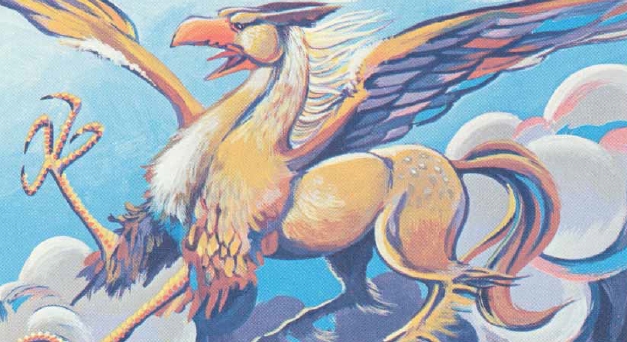

FREQUENCY: Rare
FREQUENCY: Rare ([Cold Wilderness
Mountains], [Cold Wilderness Hills])
FREQUENCY: Very rare ([Cold
Freshwater Surface])
FREQUENCY: Rare ([Temperate
Wilderness Mountains])
FREQUENCY: Very rare ([Temperate
Wilderness Hills])
FREQUENCY: Very rare ([Temperate
Freshwater Surface])
FREQUENCY: Very rare ([Temperate
Saltwater Surface])
FREQUENCY: Rare ([Tropical
Wilderness Mountains])
FREQUENCY: Very rare ([Tropical
Wilderness Hills])
FREQUENCY: Very rare ([Tropical
Freshwater Surface])
FREQUENCY: Very rare ([Tropical
Saltwater Surface])
NO. APPEARING: 2-16
ARMOR CLASS: 5
MOVE: 18"/36"
(MC: C, D
when mounted)
HIT DICE: 3+3 <(wings)>
% IN LAIR: 10% (rocky crags
&& similar places) (23 Hippogriffs: mountains or cliffs, TPL32:4th,
REF4.57)
TREASURE TYPE: [Q] (x 5)
NO. OF AttACKS: 3 ~ 16
DAMAGE/ATTACK: 1-6/1-6/1-10
SPECIALATTACKS: Nil
SPECIAL DEFENSES: Nil
INTELLIGENCE: Semi-
ALIGNMENT: Neutral
SIZE: L
LEVEL/X.P. VALUE: III |
60 + 4
SAVES: 13.14.15.16.16
Hippogriffs dwell only in
places uninhabited by men, generally nesting on
rocky crags and similar
places.
They are fierce fighters
and will defend
themselves resolutely. As
the hippogriff is an omnivore, it will never be
found with pegasi.
Griffons will attack and eat hippogriffs on occasion.
The hippogriff is able to
fight well with its two great fore claws and
powerful beak, however,
and they are not easy prey. If encountered in
their lair (nesting area)
they will attack immediately. There will be one
nest for every 2 creatures,
each nest containing 1 or 2 eggs or fledglings.
Hippogriff eggs are valued
at 1,000 g.p. each on the open market,
fledglings at 2,000 to 3,000
g.p..
Aerial
Combat: 36", class C (class D
when mounted).
Hippogriffs fight in much
the same manner as griffons.
Riding.Airborne.Hippogriff.DMG:
Hippogriffs are not so difficult to train as griffons,
but neither are they as
dependable in a pinch.
A training process basically
similar to that previously described will be necessary,
though occasionally an animal
trainer can substitute for the master for short periods if he or she is
tied up elsewhere.
Once broken, hippogriffs
may possibly serve more than one master.
They are omnivores, and
thus somewhat less expensive to feed thon griffons.
Gundwynd
NORMAL LOAD: 400#
MAXIMUM LOAD: 600#
MOVE RATE: 18 miles per
half-day
MC: D
STAMINA: 15 turns aloft,
3 turns rest

Bombay wrote:
...
...
Looking at the DMG/MM it
appears that in a nest of Hippogriffs there will be 1-2 Fledglings.
We were trying to come up
with how many might be breed in a controlled enviroment compared to the
wild. Questions have come up with "How many would she lay", "How many times
a year might she lay Eggs", "How long would it take for those born, to
be at the age they themselves can be breed". Has anyone in your campaigns
done such? Could you give any further insights into something like this?

Not an LA game question,
but I;ll answer it anyway--off the top of my head as someone that raised
ho9rses for a few years>
Assume that a hippogriff is rather like a horse, so one clutch of eggs per year is the maxumum. In captivity, breeding success will be around 50%--the creature is not meant for domestication.
On average for each mare there will be one and a half hippigriff chick-foals every other year, so three of them in four years.
Maturity, and thus capacity
to be treained as a mount for a foal is five years.
The useful working life
of a hippogriff c. 12 years.
Cheers,
Gary

Mr. Reaper wrote:
Gary, you should have referred
him over to Tim Kask, heh :wink:
(second part of this post)
http://www.dragonsfoot.org/forums/viewt
... 867#457867

Heh...
I had forgotten Tim's lengthy
treatis on hippogriffs...and the gag about a dwarf in horse barding.
The latter cracked up up
many a time back in those halcyon days.
I had to laugh at Tim's description
of the fanazines, their contributors and quality of the material therein.
Most of the mental midgits
that berate me for what I wrote about their material are irate that I dared
to respond to their drivvel and do so with far more effect that their drek.
I did indeed take considerable
joy in using a battle axe, not a rapier,
when responding to their sophomoric attacks.
Cheerio,
Gary